Waht Length Dress Did Women Wear in the 20s
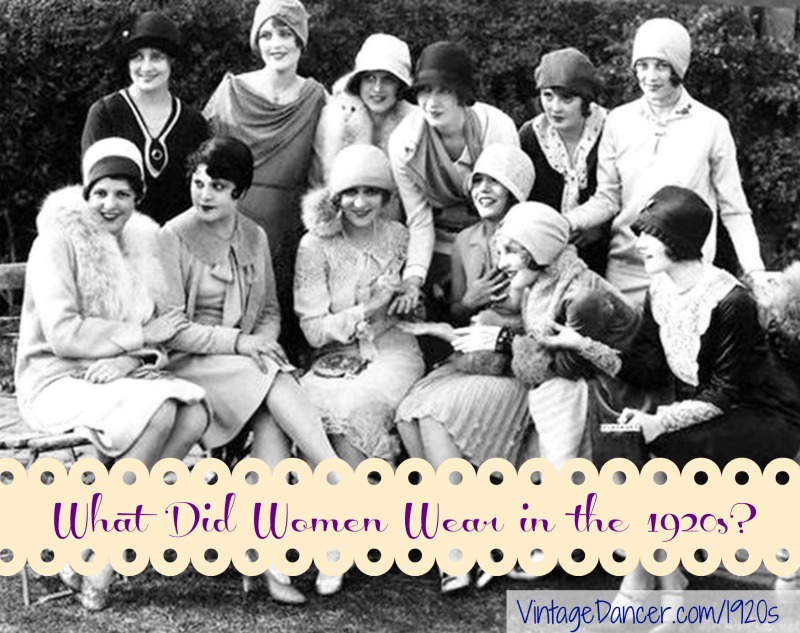
To properly answer the question "What did women and men wear in the 1920s?" would depend on what they were doing, with whom, and at what time of day. Here you will learn about the types of clothing women and men wore for specific occasions. Follow the links within for even more 1920s fashion history .
Something that stands out to me about vintage fashion prior to the '60s is how often wealthy men and women changed clothing in one day. There was an outfit for every time of day, every type of outing, and every type of party. Add to that specific types of clothing for your age, class, and occupation, and you have one huge wardrobe!
Each type of clothing in a 1920s closet had a certain set of guidelines as to when they were to be worn. What were the "rules" for morning dress, afternoon dress, and evenings? What about going to school or working?
First, let's explore women's clothing. For men's 1920s fashion, read this article.
1920s Fashion Trends for Women
- Below-knee length drop-waist dresses with a loose, straight fit.
- Beaded evening dresses inspired by "flappers."
- Mary Jane or T-strap heel shoes.
- Casual sport golf knickers, argyle socks, blouse and tie.
- Cocoon fur coats and fringe wraps.
- Cloche hats and short bobbed hairstyles.
- Bead or feather headbands for evenings.
- Long pearl necklaces, bold Art Deco colors, faux gemstones.
- Small beaded purses held pretty makeup compacts and cigarette cases.
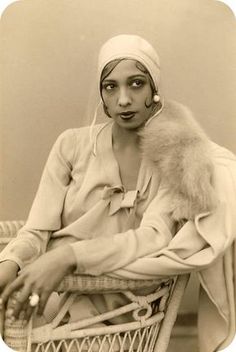
Josephine Baker- cloche hat, fur collar coat
1920s House Dresses
While at home in the company of just family, clothing was at its most comfortable state.
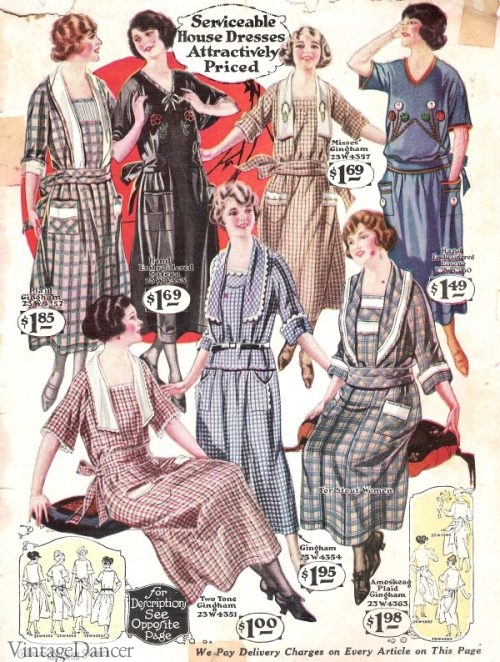
1923 cotton house dresses in plaids and checks
Advertiser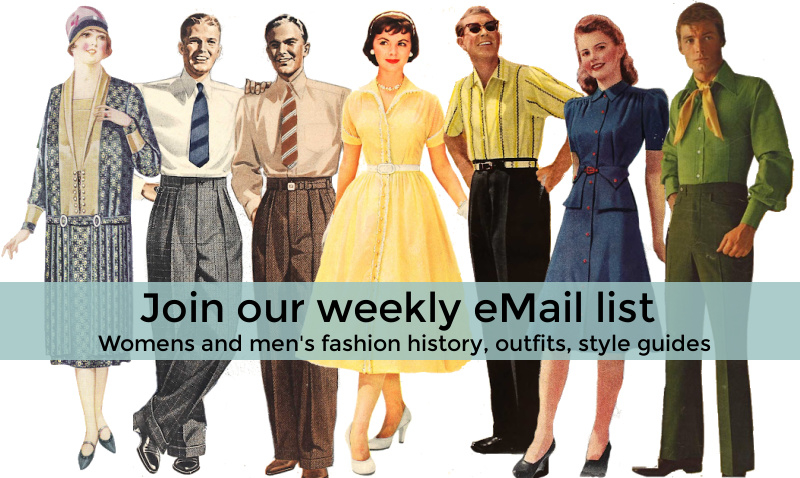
The housewife wore a simple cotton dress, thick black cotton stockings, and low heel Oxfords. Dresses were colorful plaids, checks, stripes, or solid colors with pretty embroidery and trim such as lace or rick rack. Housedresses often had white collars.
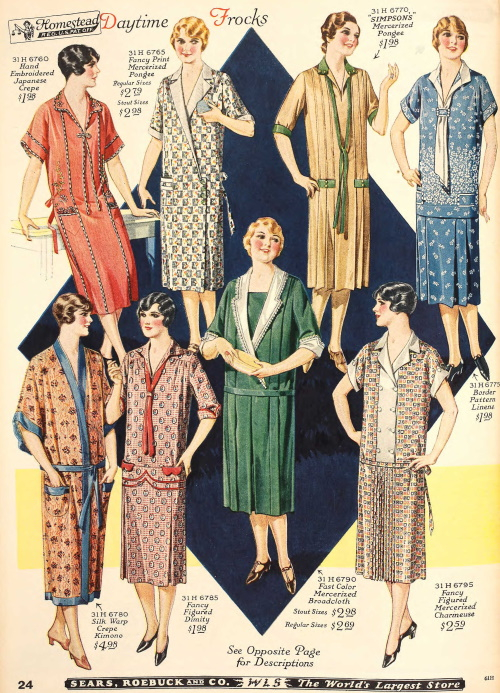
1927 house dresses and day dresses
A woman's apron was usually handmade. The housedresses and aprons were basic, yet durable enough for the rigors of 1920s household chores (vacuums, washers, and irons were just entering the marketplace). For the very poor, a cotton housedress was the only outfit for the day.
Shop 20s house dresses/day dresses.
Advertiser
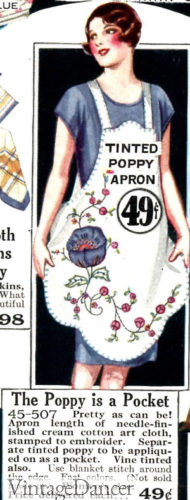
1928 decorated apron
Work Clothing
Women in manual labor such as factory work, sewing, nursing, maids or nannies, and foodservice were required to wear specialty uniform coat/smock or apron over a cotton house frock. Girls who worked as shop assistants had to dress a little nicer, with a daytime dress or a uniform of shirtwaist dress with a white collar.
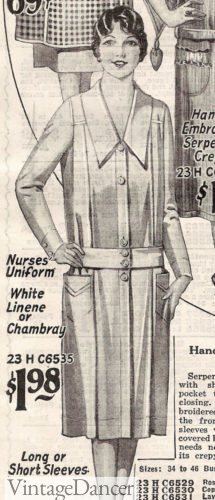
1927 nurse uniform
Even while working at a silk mill, young women took the time to stay on the fashion trend. Here a worker in 1924 has the latest bobbed haircut and what appears to be canton silk (silk and cotton) blend dress with an embroidered waistband.
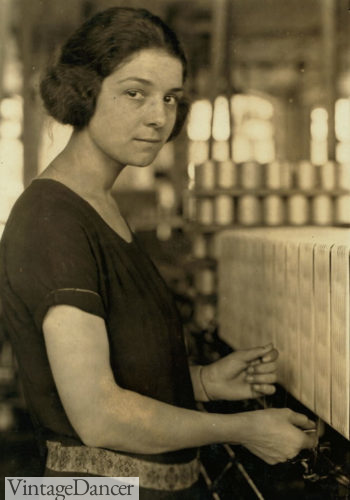
1924 silk mill working woman
For women who worked professional jobs– such as teachers, secretaries, journalists, and telephone operators– a modest day dress or skirt and blouse set was worn. A three-piece suit could also be worn.
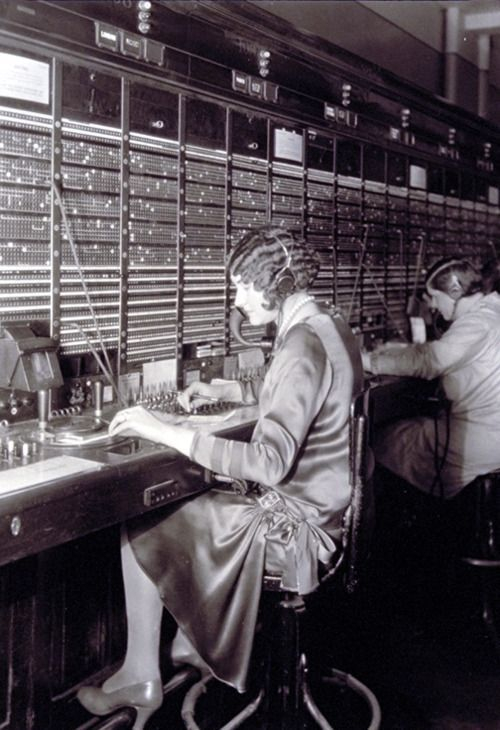
A telephone girl wears a nice dress for her job (she probably dressed up for this photo- her neighbor is wearing a simple cotton dress, possibly a uniform)
Traveling Clothes
Traveling in the 1920s was a dirty affair. Cars were dusty, trains were hot, and buses were so packed with commuters that people were bound to be a wrinkled mess by the time they arrived at their destination. For those reasons, 1920s traveling clothes, for both men and women, were simple suits, a sturdy overcoat, a comfortable hat, leather gloves, a leather purse or luggage, and low profile shoes.
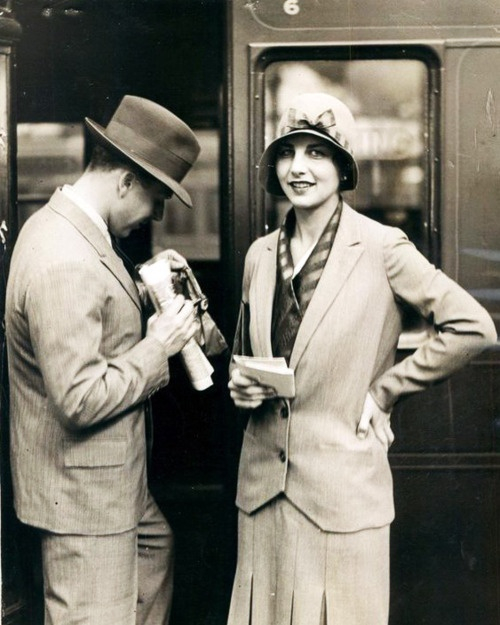
Late 20s traveling suit
Colors were neutral greys, browns, and blues that showed the least amount of dirt possible. Materials that wrinkled, like linen and cotton, were avoided and instead knit, wool, or sturdy cotton blends were preferred.
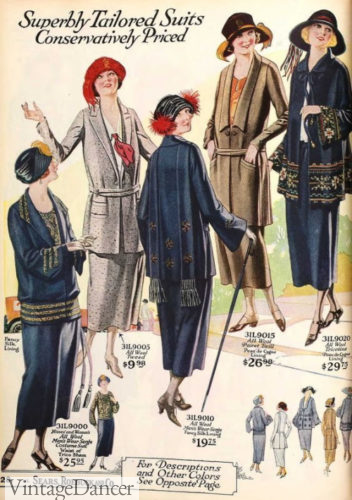
1923 ladies suits
If travel required an overnight stay, a woman would have packed a conservative tailored pajama or nightgown. She was sure to pack all of her own toiletries so she would not inconvenience the host!
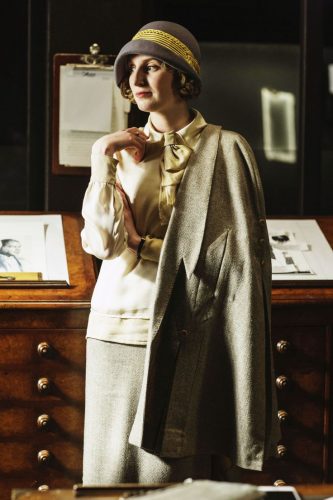
Women's office attire: Suit jacket, blouse, skirt and hat
Street Wear, Daytime Clothes
When a woman was done with her housewife chores, it was time to run some errands while her husband went to work. Clothing was still simple but of a higher quality than cotton prints. A walking suit (skirt, blouse and sweater) paired with a sturdy pair of mid-heel Oxfords, Mary Janes, or T-Strap shoes is the most utilitarian of the daytime dress.
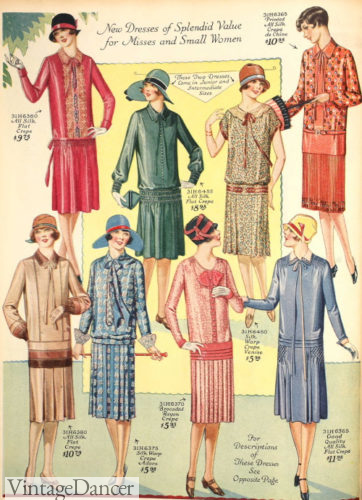
1927 daytime dresses
A tailored dress made of a silk blend crepe or wool was also appropriate. These dresses featured a natural waist sash in the early 20s that gradually moved down into a drop waist with a thin belt by 1926. Dresses fit loose and usually slipped on overhead.
A small collar or wide open flat collar with a bow tie at the neck was essential to the '20s wardrobe. Details were added to the dress that elongated the body such as vertical pintucks, a long necktie, a row of buttons, and pleated, draped or tiered skirts.
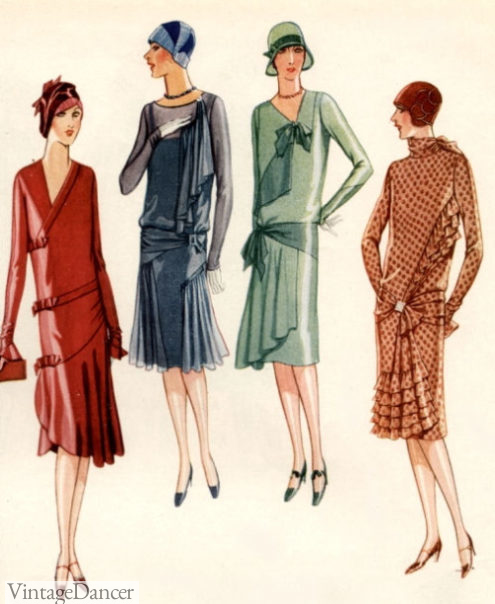
1927 dressy afternoon styles
Colors for city folk were a bit on the drab side: black, navy, grey, tan, and olive green. Country folk and seaside dwellers liked color: white in summer, yellow, red, blue, and light grey year-round. The difference between city and country clothing in Europe was far more pronounced than in America. Americans loved to disobey fashion "rules" and wore whatever color they personally liked. See 1920s fabrics and colors in fashion.
Learn more about daytime 20s dresses here or shop daytime appropriate dresses online.
Accessories with a suit or dress would coordinate, but not match, a woman's outfit, and were kept simple. Jewelry was left at home, but a cloche hat and gloves were essential. Stockings were matte and only semi-sheer at the most, in black or tan.
The hat is one accessory that women never left home without. There were hats for summer (woven straw, cotton) and winter (felt or hand sewn cloche hats). Hat trends included the tricorn when the Three Musketeers movie was popular, turban for fancy afternoons and evenings, the beret for the young lady, and a wide brim sun hat for garden parties.
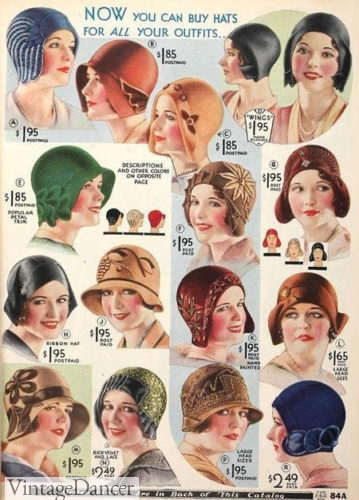
1928 cloche hats
The most iconic hat was the cloche, meaning "bell" because it was shaped with a round crown and a small brim. Women often had to tilt their head back to see clearly while wearing a cloche. Hats had less decoration than they did in previous years, but were still quite pretty with a bow, flower or Art Deco shape on one side.
Read more about women's 1920s hats. Shop 1920s style hats.
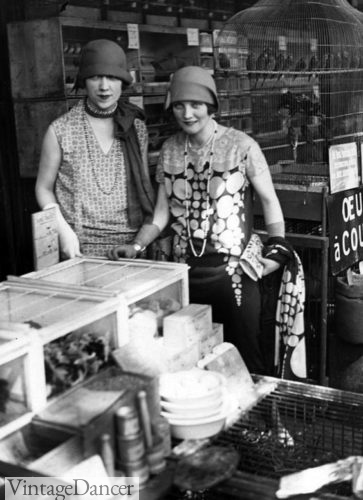
1925 young flappers dressed up in afternoon dresses with hats, scarves, and jewelry.
Church Clothing / Special Events
Surprisingly, wearing Sunday's best was not part of the '20s culture unless a woman was poor and only had one nice outfit– then, certainly, she MUST wear that to church. Otherwise, whatever she wore for streetwear / afternoon attire she also wore to church, as long as it was modest with long sleeves and a below the knee hemline.
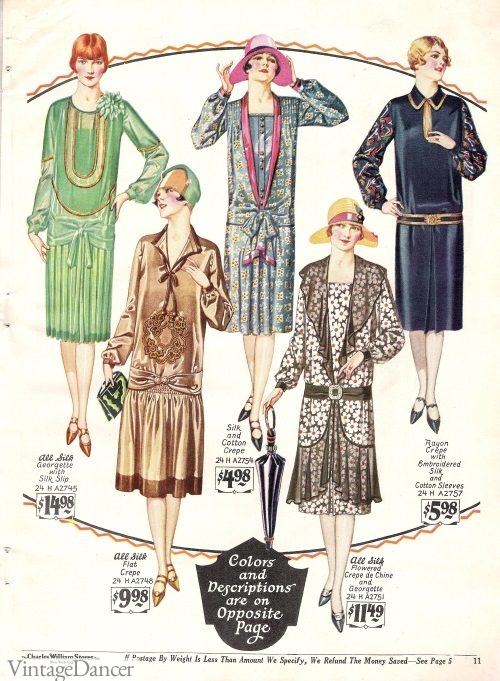
1927 long sleeve summer dresses for Church
If a sleeveless dress was worn, a light shawl, wrap or jacket acted as a light coverup. Simple, non-distracting clothing was appreciated in church. Women were required to wear a hat, gloves, and a matching purse. These three accessories polished her look and gave her permission to add personality to an otherwise conservative dress.
Shop 20s dresses – day, party and evening styles all together. Over 500 choices!
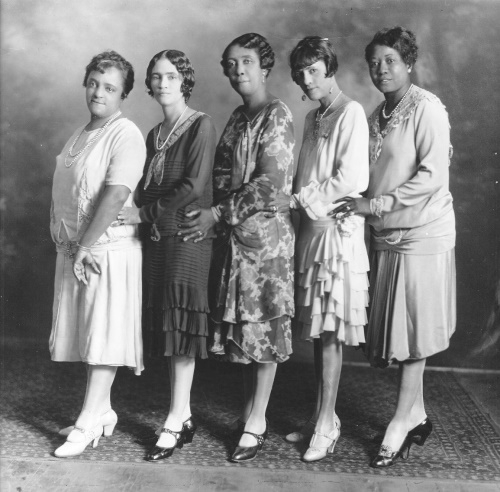
Afternoon dresses worn with pearl necklaces
Daytime or afternoon styles dresses may be more difficult to buy than a beaded flapper dress. Read these articles to help you find or make the perfect dress:
- 1920s Style Dresses in 2020 – How to spot a 1920s style day dress from popular new dress style in fashion now.
- 1920s DIY dress ideas – How to put together 1920s inspired outfits from new or used clothing.
- Sew a 1920s dress in any size from the One Hour Dress pattern (it will take at least 2 hours to make).
- How to Accessorize a 1920s dress – Ideas to make a basic dress more 1920s. Belts, sashes, trim, wraps, etc.
- Plus size fashion in the 1920s – Be inspired by curvy ladies wearing real 1920s fashions.
- 1920s Outfit Inspiration- Women 20s Costume Ideas
Afternoon Tea Dresses, Party Dresses
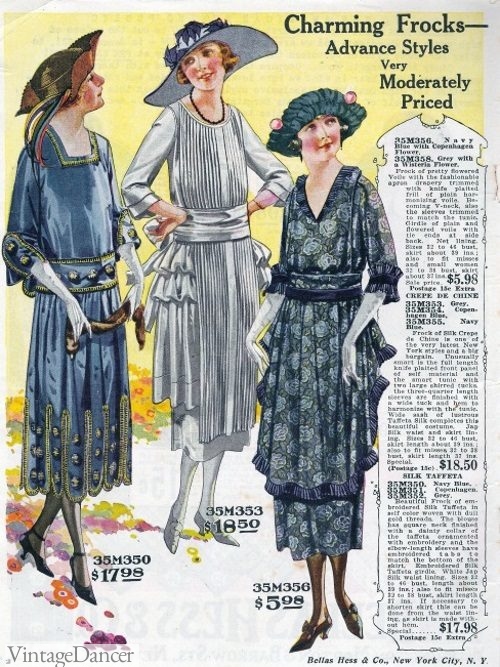
1921 tea party dresses
A woman's most common social activity was having tea with friends. Tea parties could be semi-formal or formal. A tea dress was an afternoon dress made of lighter, brighter materials and more trim. The afternoon dress was a thing of sophisticated beauty. White dresses worn in summer were very attractive, while pastels or rich jewel tones offered variety in the other seasons.
Shoes and accessories were more dramatic, too. Shoes would be slip on pumps or one strap Mary Jane heels in medium or high height. Stockings would be sheerer and in white or colors to match the dress. Gloves would also match or be white (and were taken off to eat, smoke or use the restroom). A hat would be whatever is most becoming to the dress, such as a feather trim sun hat or decorative cloche. Carrying a parasol was a popular beach or summer party accessory.
Learn more about dressing in afternoon party dresses.
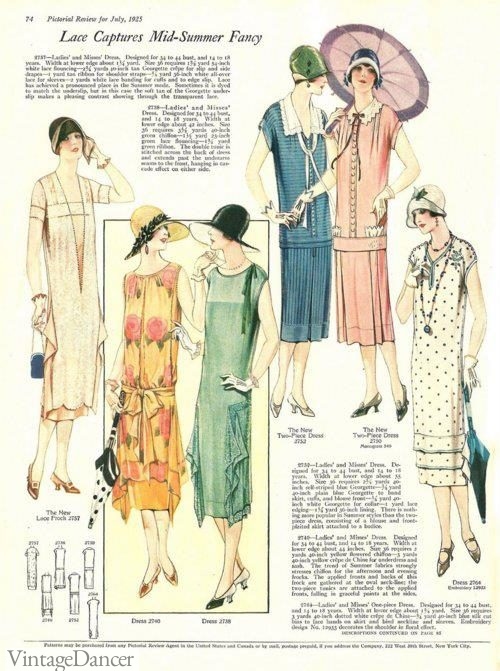
1925, dresses for church or afternoon garden party
If a woman is to host the tea, then etiquette calls for her to NOT wear a hat and to keep her dress long and elegant. I don't quite understand the no hat rule, other than it just sets her apart from the sea of hatted guests. Instead, I imagine she would have had her hair styled specially for the occasion.
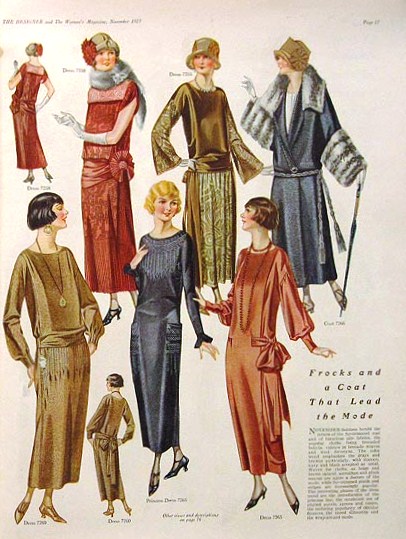
1923 tea gowns or formal day dresses in winter
1920s Shoes
Women's shoes became more delicate and pretty over the roaring '20s decade, simply because they were more visible under short dresses. For daytime use, the low heel lace-up Oxford shoe in brown, white or black was worn every day. For something a little nicer when going out or dressing up, it was the classic Mary Jane heel with a single strap across the front.
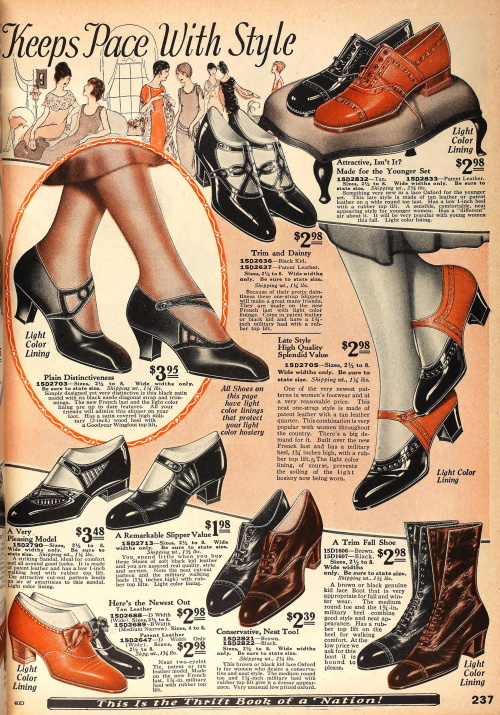
1925 shoes: mary jane heels, oxford with low heels, lace up boots
The late 1920s T-strap heel is the most famous evening shoe because the two straps held onto the foot while dancing the Charleston. They often came in black and gold or silver with hand-painted heel designs that stood out on the dance floor. Straps and buckles were also decorated on fancier models.
There were basic slip-on pumps, low heel pumps with toe buckles inspired by colonial-era shoes, and multi-strap heels in the early '20s as well.
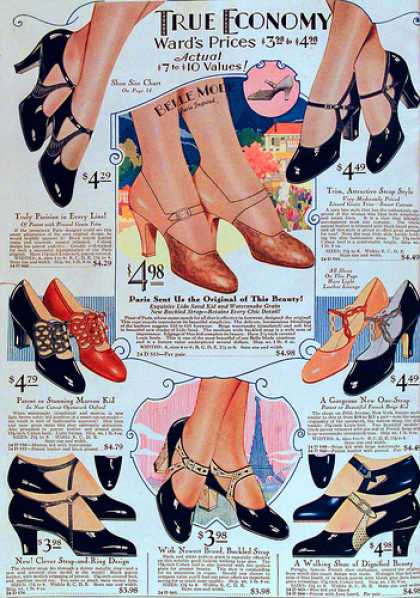
1929 shoes with heels
While flats were uncommon, you can find Mary Jane and T-strap shoes in the low heel or flat sole, as well as wide and narrow shoes and even specialty dance shoes.
For sportier occasions, the two-tone Oxford (saddle shoes? yes) or classic Keds white sport sneakers were best for playing on grass or dirt. Hiking boots were very tall lace-up boots. Granny boots with a French heel were still worn by many mature women instead of shoes.
Learn about the history of 1920s shoes or shop for 1920s style shoes (USA) and UK here.
Casual Outfits / Knitwear
Those college kids get to have all the fun fashions. Being away from parents (who did their laundry) and in a fashion-forward subculture, college kids wore sportier clothing such as knit dresses, knee length knit suits, knit sweaters, knit vests, knit socks, knits gloves… knit knit knit!
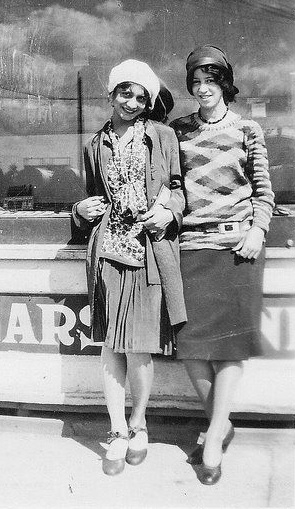
1928 knit sweaters and skirts
They wore cotton, linen, silk, and rayon dresses, too, but knitwear was sportswear and sportswear was what every trendy college kid was wearing.
As for shoes, you guessed it, sporty two-tone Oxfords, T-straps, and pumps were in vogue, and flashy satin sandals were out.
In winter, wearing a raccoon coat was high fashion! Fur collar cocoon-shaped coats were also trendy and a bit more affordable.
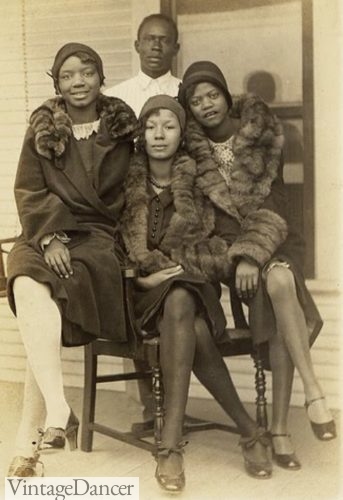
Fur collar coats
A sorority girl living in a community house needed a lounging robe or house jacket and slippers to remain modest. Her busy school schedule did not excuse her from changing clothing several times a day.
"Each girl's wardrobe should contain an extra dress or two which can be worn to meals. At breakfast and lunch, the girls will of necessity wear the dresses they wear to class. At dinner time they should change into something different. They will find themselves fresher in appearance and will be more sociable if they take time to change clothes before the evening meal." (Textiles and Clothing / by Elizabeth Sage.)
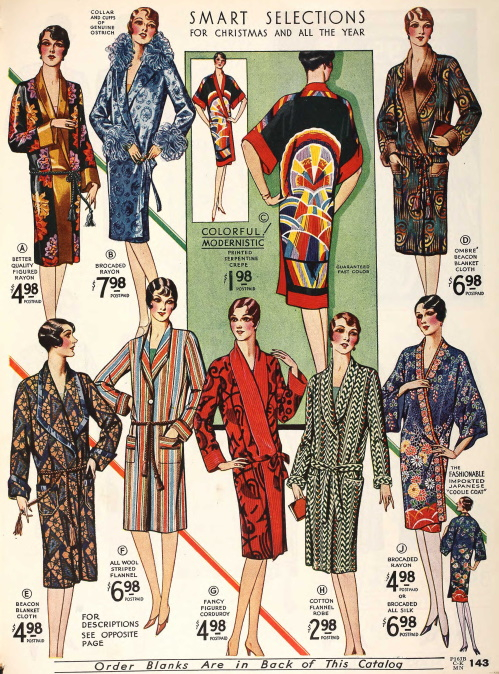
1929 kimono robes
Sportswear
Specific sports called for different types of clothing; however, there were two primary sets. The first set was worn by golfers, tennis players and other ladylike sports. It consisted of a long or tea-length skirt, long sleeve blouse and a loose-knit vest or sweater. A thin belt tied the waist in.
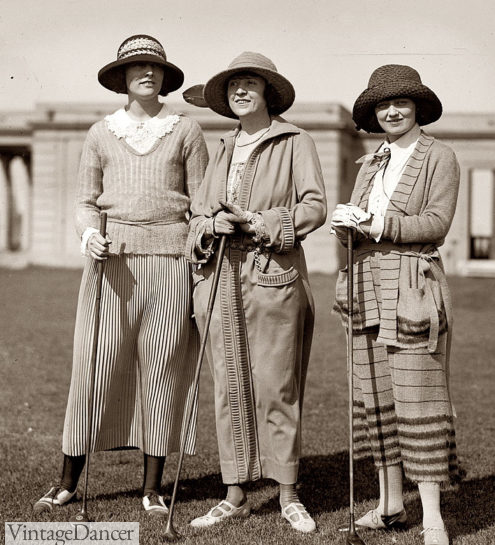
1923 women in gold clothes: pullover sweater, long coat and cardigan sweater
A low heel Oxford or flat saddle shoes were best on grassy surfaces. It is a look similar to the college style above.
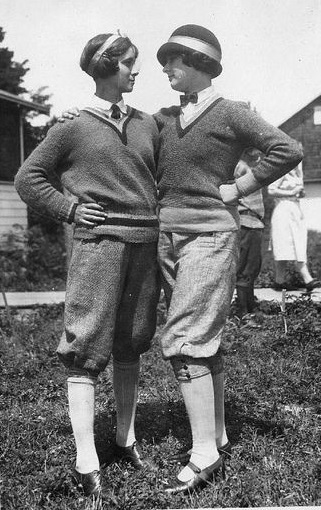
1920s sporty attire with knickers, sweater, shirt and tie. Helen Richey, the first commercial female airline pilot in the USA, is pictured.
The second look was for more vigorous outdoor activities, such as hiking, riding, camping, and fishing. Instead of a skirt, women wore wool knickers (also called plus fours, togs, breeks or jodphurs). They were wide and baggy around the hips with a button cuff below the knee.
Women also wore thick stockings or knee-high argyle socks with a pair of flat Oxfords. A button-down shirt with collar and a skinny black tie gave a nod to menswear. Knit vests, pullover sweaters, and long cardigans added warmth. Many men did not appreciate this masculine look, but young adventurous women loved it.
Being able to wear pants (knickers) and "men's" clothing gave freedom to a new generation of women who embraced non-traditional roles. See more non-flapper outfit ideas here.
The all-white tennis outfit was another popular summertime outfit while playing or watching tennis and other sports.
Beach Attire / Vacations
Weekends and vacations were a new trend in the 1920s. Beachside destinations were the most popular, and one where casual comfort was of the utmost importance. White or navy dresses with a nautical or sailor theme (middy top and pleated skirt) were what all classes would wear.
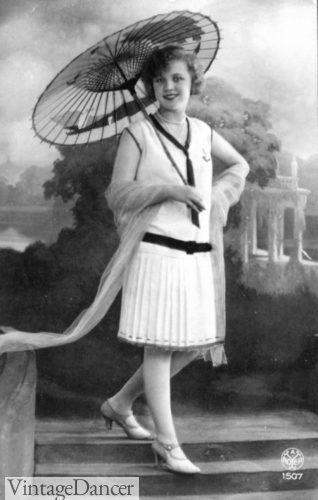
A summer white dress with blue sailor necktie
Upper classes in the late 1920s began wearing a pants ensemble called beach pajamas. They were inspired by Asian prints with wide legs and a kimono-style top or jacket, they were one of the few times women could wear pants. Read about the this and other types of women's 1920s pants here.
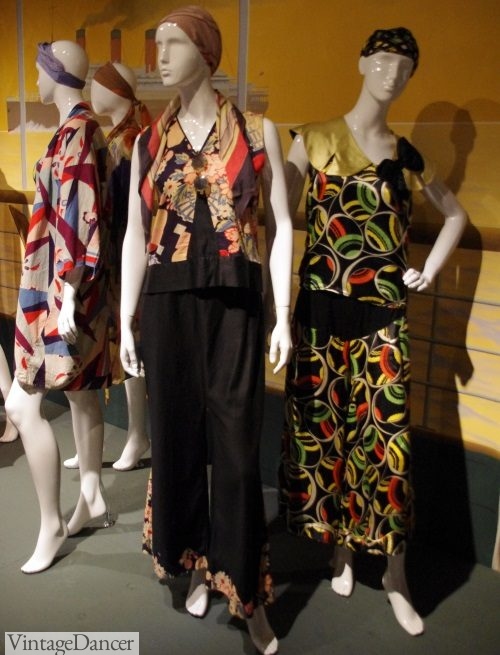
Late '20s Beach Pajama
Some women wore beach pajamas while lounging at home or playing a game of mahjongg. Miss Fisher wears quite a few flowing wide-leg pant and kimono coat ensembles while solving murder mysteries.
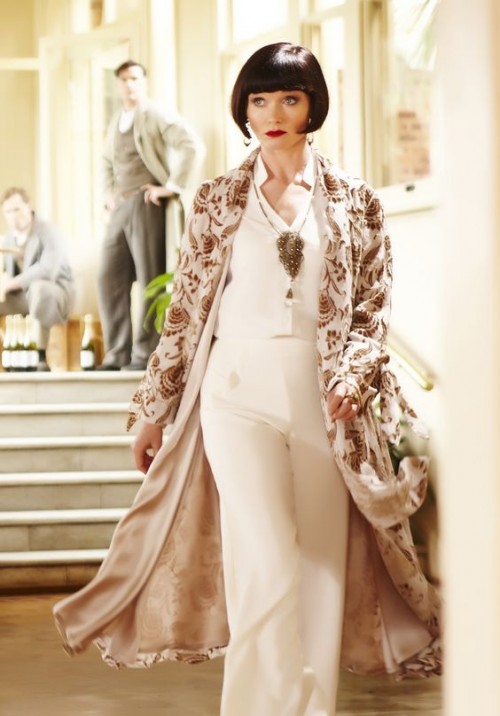
Miss Fisher wearing a white pant ensemble with kimono coat
Shop 1920s pants and beach pajamas.
Dinner & Dancing
Like tea parties, dinner with friends or going out to a restaurant would have been semi-formal or formal. If the occasion was semi-formal, then an afternoon dress/tea dress attire was all she would have needed.
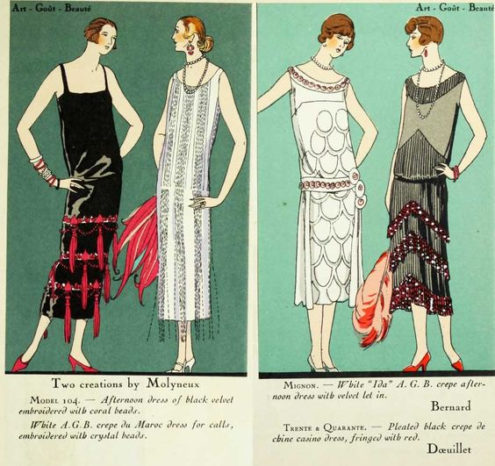
1924 Long evening dresses
Evening dresses were made of fine materials like silk, chiffon, taffeta and light velvet. They were usually sleeveless for young women or had long sleeves for older women. Dresses featured the iconic '20s drop waist with layers or tiers of fabric creating some fullness from the waist down.
Beaded dresses were the most glamorous and the most expensive. Some had fringe or metal sequins, but this was quite rare. The short fringed flapper dress is a '20s myth. Real flappers wore knee-length or longer gowns that swished and swayed while dancing to jazz music.
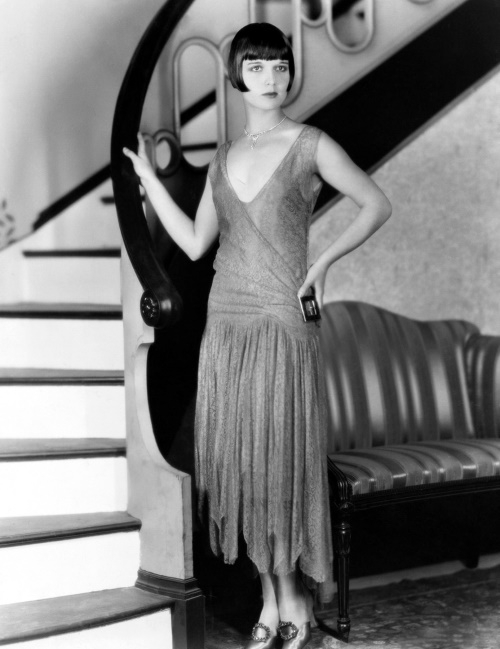
c. 1925: Louise Brooks standing by the stairway in a formal beaded "flapper" dress.
Shop 1920s party dresses- flapper dresses or long, formal evening gowns.
For more dresses in the UK, look at these and for AU/ NZ try these 20s dresses.
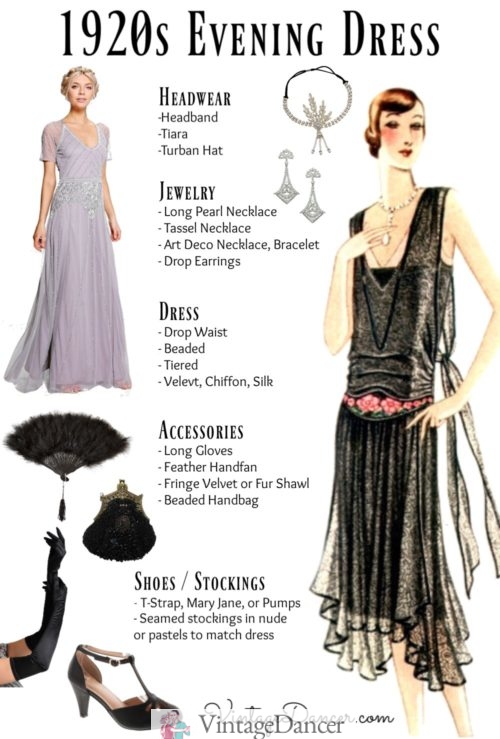
How to accessorize a 1920s evening dress
Hats were not appropriate for eveningwear unless it was a turban. Headbands, crowns, and hair combs were more appropriate in the first half of the decade, none in the second half.
The evening purse, too, would have been of a formal nature and made of sequins, gold mesh, glittering beads, or other colorful materials.
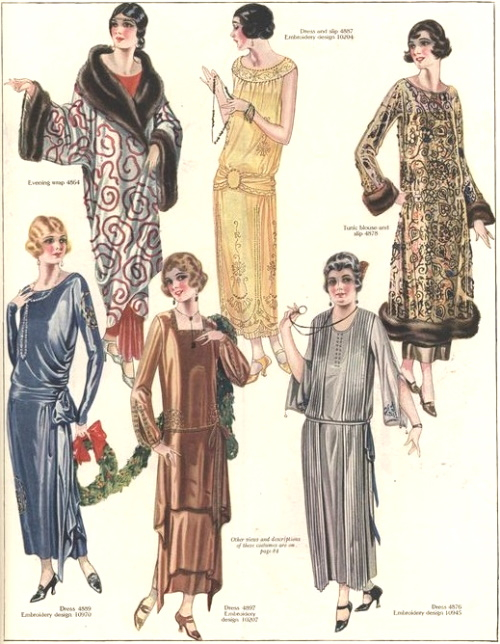
1923 long evening dress and opera coat
It would have also been wise to wear a matching dress jacket, fringe evening shawl, or fur wrap to a formal affair. Jewelry was minimal, perhaps a long bead or pearl necklace, drop earrings, and a bracelet were optional. Accessories such as long gloves, a hand fan, fringe shawl or boa, and cigarette holder were also glamorous additions.
1920s Mature Women's Fashion
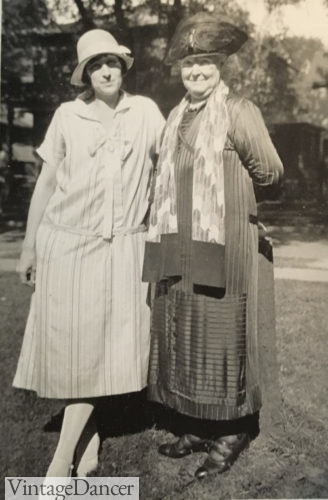
1920s Young woman on the left wearing an early 1920s dress while her mother on the right is in the clothing of the late 1910s.
Not everyone was a bright young thing in the 1920s, nor did they want to wear the latest fashion of drop-waist dresses. Many mature women continued to wear the fashions of 10 years prior to the 1920s. This meant long, modest, waistless tunic dresses, in dark rich fabrics.
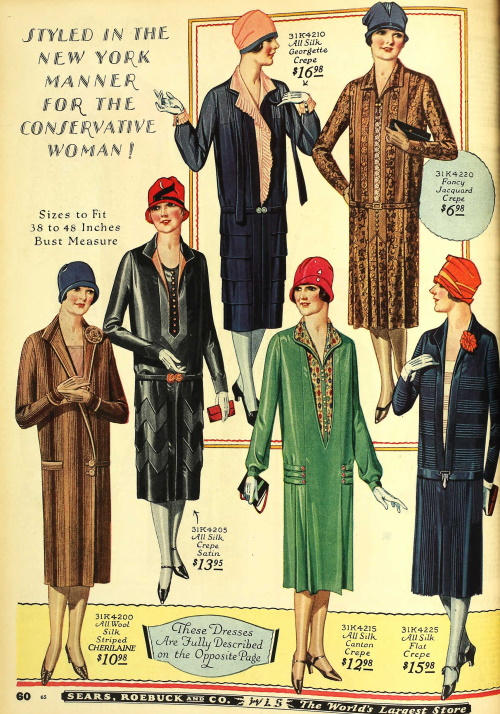
1927 Conservative dresses for mature women
Tall lace up boots or strappy heels were more comfortable for women who grew up wearing them. Hats were larger as well, not the helmet cloches of the roaring twenties.
For the mature women who chose to dress more modern, there were styles that were modest and simply decorated. Lane Bryant was one of the first mail-order catalogs to design garments for the mature, plus size and maternity market.
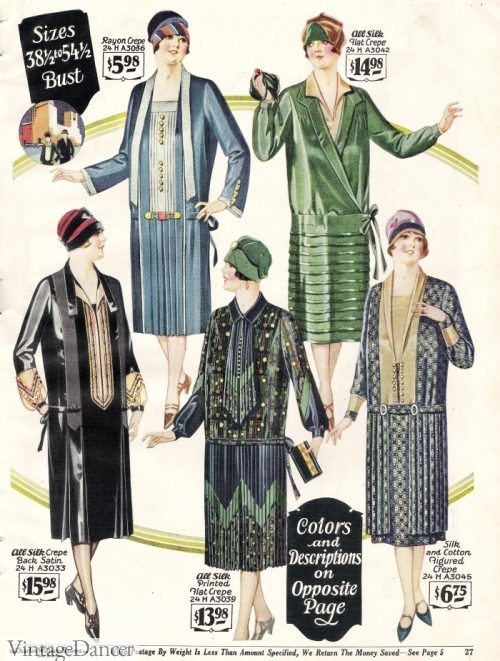
1927 drop waist in plus dresses dresses
Most of the Lane Bryant fashions were modeled after the same designs worn in the mainstream, however, designs were usually of solid colors or small all-over prints with vertical lines created by long pleats, long lapels, and narrow belts.
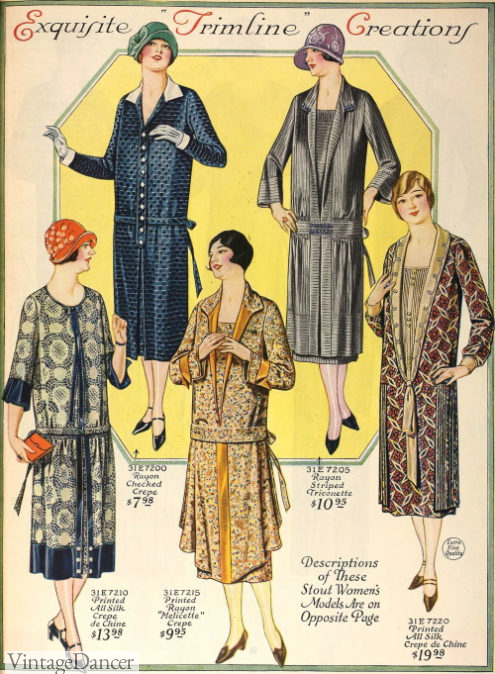
1926 plus size fashions
Long sleeves and matching jackets were usually paired with straight-line dresses. These style details elongated the body and looked flattering on women of all shapes and ages. That doesn't mean you, as a modern woman, will be happy in the 1920s style dress, but half the battle is choosing the right design and making small alterations to enhance the '20s fit. Learn more with this free eBook.
Shop plus size dresses and mature women's dresses with sleeves.
More Outfit Ideas
- Read 10 easy 1920s costume ideas that are simple to put together from things you already own. Day and evening dresses, casual clothing, gangster girls, garden party, DIY, thrifted and more.
- Ten 1920s Outfit ideas – Looks inspired by the 1920s costumes in the Downton Abbey TV series. Day, sporty, summer and winter looks.
- How to dress like a 1920s flapper – Love the iconic flapper girl costume? Read this article for tips on staying authentic yet fun!
- Non-flapper outfit ideas – Simple dresses, separates, pants, sportswear and non-beaded eveningwear outfits.
- 1920s Outfit Inspiration- Women 20s Costume Ideas
- One Hour Dress Tips and Reviews – Sew a basic dress in only 2 hours. See many examples of how to adapt this vintage 1924 pattern into day and evening looks. This article on accessorizing a plain dress will help too.
- 20s costumes – cheaper Halloween costumes are affordable and fun! Look here for gangster girl costumes
- More articles on 1920s fashion history can be found here.
What Did Men Wear in the 1920s?
The following is a brief summary. For a more detailed article read 1920s Men's Fashion History.
A 1920s man dressed for his class or his job more than for an occasion, like women did. Upper-class gentlemen dressed in the finest suits, middle-class businessmen wore similar (but not as expensive) suits, and working-class men were in laborers' clothes. Outside of work, men wore casual sporting clothes on the weekends.
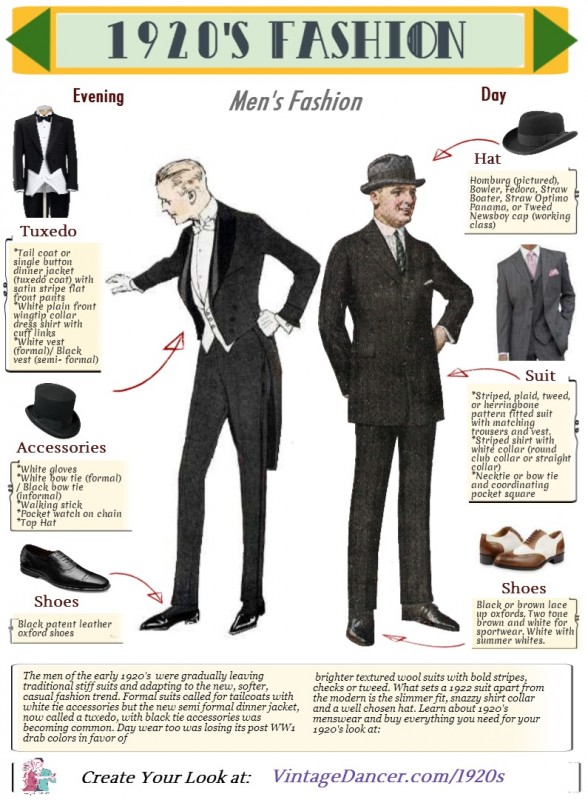
1920s Day and Evening Men's Clothing Guide. Learn more.
Men's Business Attire
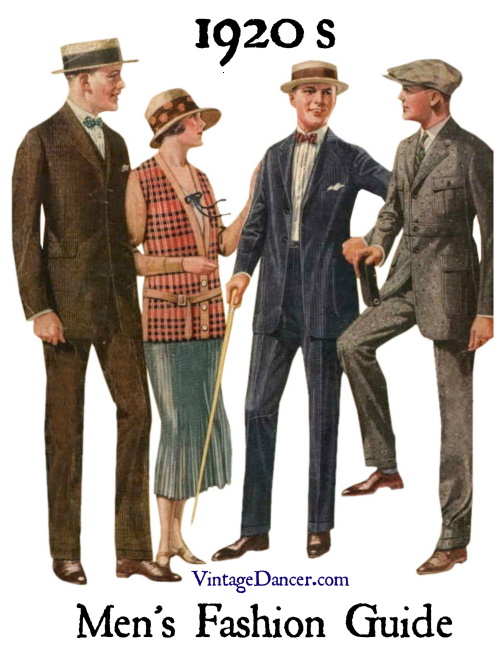
1920s men's summer suits
A working family man would put his work clothes on almost immediately in the morning. He may have also put on his robe or smoking jacket while eating, reading the paper or fixing his hair.
A businessman wore an appropriate 3 piece suit to the office on business calls and often to dinners and parties, too. He was not subject to the multiple changes of clothing as women were. The type of suit changed with his seniority at work and the season. Some men in upper-level positions still wore men's formal morning suits with cutaway coats, striped pants, cravats, and vests to work.
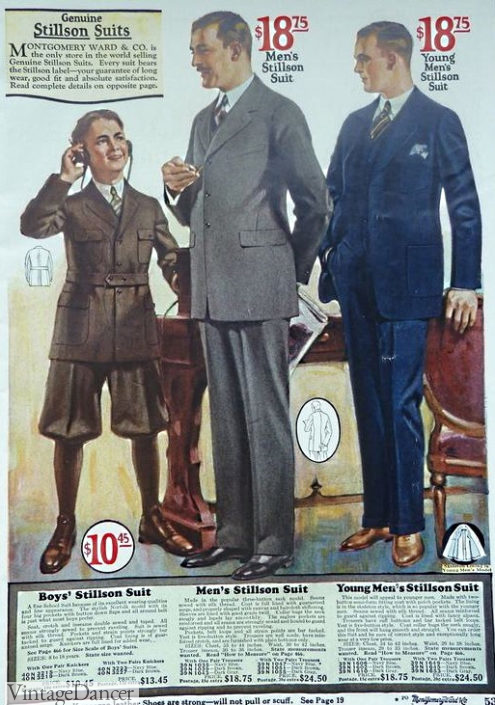
Mid 1920s conservative men and young men suits
Everyone else wore the quality of suit they could afford. Usually, a man had 3 or 4 suits he would wear during the week, changing shirts daily. Business suits were purchased with an extra set of pants since they wore out quicker than suit coats and vests. Dress shirts were striped with white round or pointed collars that were detachable up until the late 1920s. Cufflinks were also necessary. Learn more about men's shirts here.
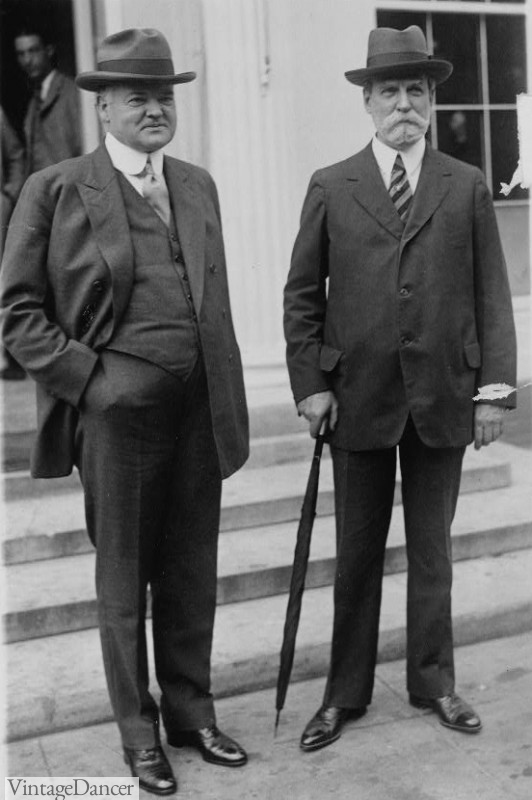
1925 Secretary of State Hughes wearing typical '20s business suit
In the early years, suits were slim and plain colored. By the mid '20s, the wide leg look with a loose suit coat made men much more comfortable. These also came in bolder wide stripes, big checks, windowpane, plaid, and tweed fabrics.
Gentlemen's suits in the summer were nice white linen or seersucker suits. Suit jacks buttoned up with 3-4 buttons to mid-chest. The jacket hung down to the upper thigh and was worn over a matching lapel collar vest. Both coat and vest lapels were quite wide. The skinny "jazz suit" was a brief fad in the very late teens/the early '20s only. Men wanted wide, loose clothing that felt as comfortable as their weekend attire starting around 1922.
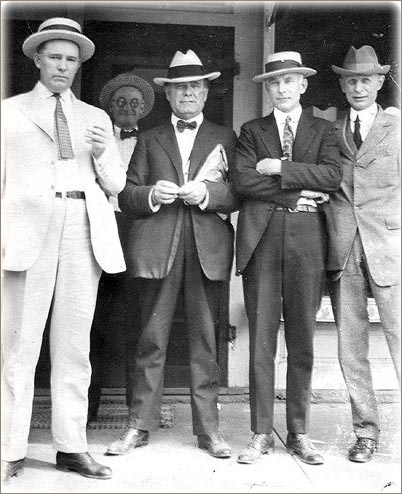
Men in summer suits and straw hats
Suit pants were wide, too, by the mid-20s. They fit very high on the waist and had to be held up with suspenders. They were usually flat front, creased down the center leg, and cuffed at the bottom. Men could wear a belt, too, but they were less common.
Suit accessories included a necktie or bow tie in patterns of wide stripes, small dots, and paisley. They were often coordinated with the pocket square folder in the chest pocket. Some well-dressed men wore a collar pin under the necktie to hold the collar in place. In cool weather, a wool topcoat kept a man warm.
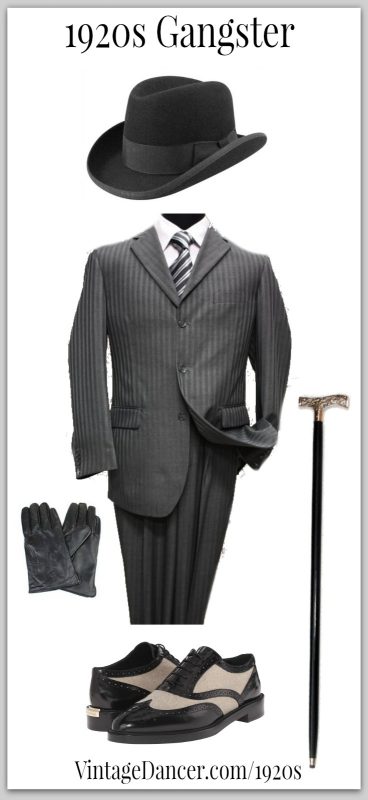
1920s Gangster look – Black Homburg hat, dark grey striped suit, two-tone shoes, leather gloves and a walking cane (or is it a weapon?)
Notorious gangsters and bootleggers of the 1920s wore 3 piece suits, too. What they wore was determined by their wealth, not their uh… occupation. Some well-to-do gangsters were known for wearing white spats over their boots, just like men did in the early 1900s. A walking cane or rolled umbrella was another accessory that said "old money." Younger gangsters (the muscle and weapon men) wore whatever suits they could afford. They often did not have matching vests, and they fit poorly since they were purchased second hand. Learn how to dress like a 1920s gangster here.
Men's Summer Suits
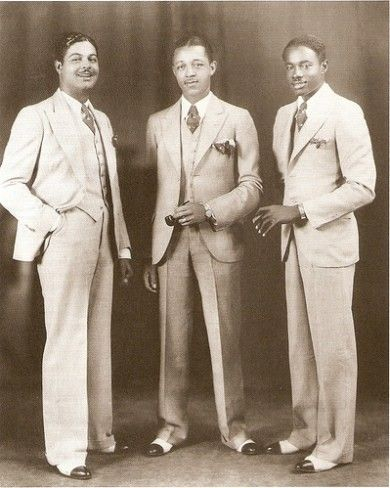
Dapper men in light cream/tan wool summer suits, two tone shoes
In summer, an all wool suit was too hot. Instead, men turned to light flannel, striped seersucker, or linen suits. There were a few years where pastel colors were popular such as the pink suit Gatsby wore, otherwise white, ivory, or beige were the best colors. Some men paired white pants with a double-breasted blue blazer for a yachting or nautical look.
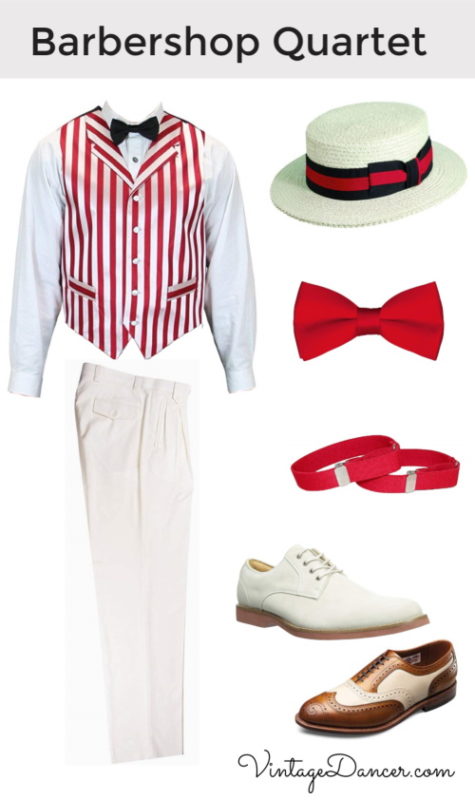
1920s barbershop quartet/musician costume
Musicians and college kids often wore wide striped blazers over white pants as a summer outfit. This look was popularized by Barber Shop quartet singers, ragtime pianists, and traveling salesmen (AKA The Music Man). Some modern costumes skip the blazer and wear a striped vest, bow tie, and armbands/sleeve garters instead. A straw boater hat completes the festive summer outfit.
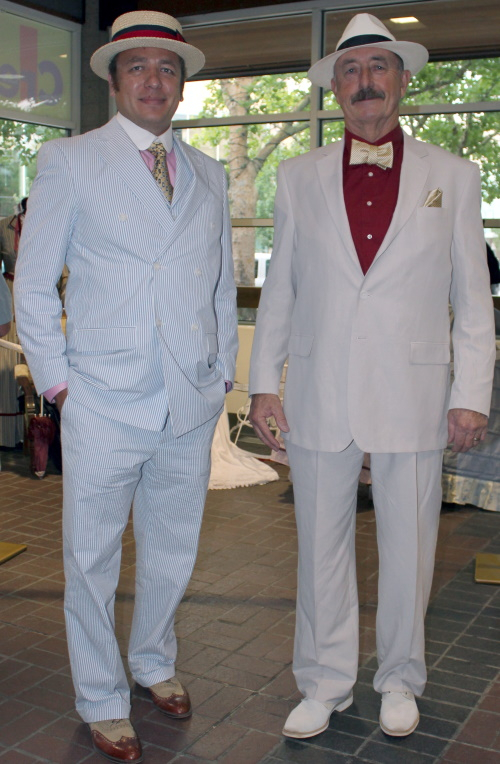
Seersucker suit on the left, ivory linen suit on the right. Both are perfect for hot summer events.
1920s Men's Hats
Men wore hats out of the house just as the ladies did, although they were always taken off inside, which led to many men losing hats when placed on a community hat stand. Popular felt hats were the round bowler or derby hat, followed by the Homburg with a center crease in the crown. The felt fedora hat was a newer trend with a more casual appearance for the middle classes. Various other hat styles were shaped from felt or straw with rolled brims or tall crowns. A hat did not need to match a man's suit, but should not stand out either. Common colors were grey, black and brown wool felt.
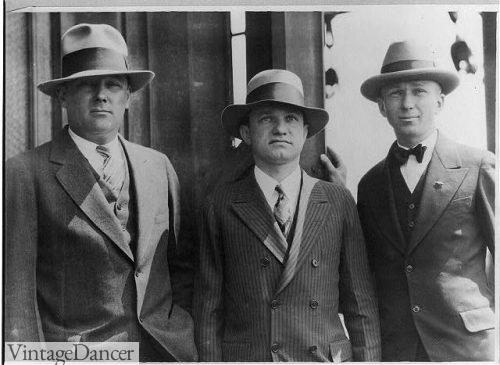
1927, men's felt hats (L) Fedora, (M) round crown and (R) Homburg.
In the summer, men's felt hats were tossed aside in favor of lighter straw hats. The straw boater and skimmer are what most of us think of as men's '20s hats. They had a round flat crown and striped ribbon that often represented a gentleman's club or college colors. The lightweight straw Panama hat was expensive but much nicer than other thick straw boater hats. By the end of summer, straw hats were in shambles and thrown away. Learn more about men's hat styles.
1920s Men's Shoes
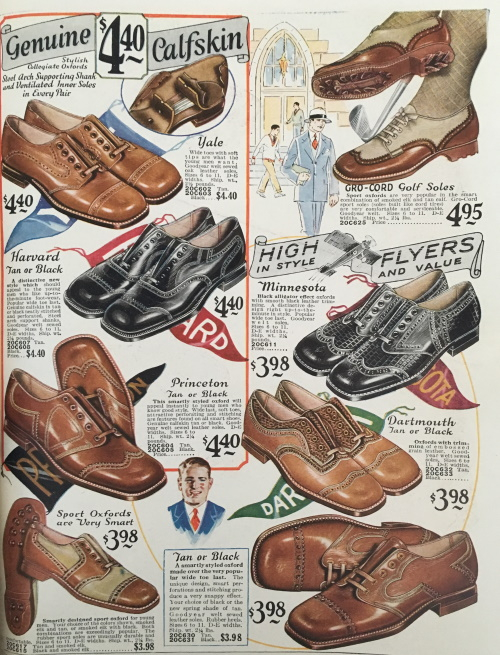
1928 men's shoes
Men's dress shoes consisted of lace-up cap toe, wingtip Oxford, or derby shoes. The most dressy Oxford was the wingtip with a distinct W design on the toe. Most middle-class businessmen opted for the simple cap toe Oxford in brown or black or white nubuck in summer. Some old men continued to wear lace-up dress boots.
With snazzy new suit colors came the trend of two-tone Oxfords. Usually brown and white, they looked very dapper. Saddle shoes in brown and white were another casual shoe, although a few came in black and white. Learn more about 1920s men's shoe styles.
Men's Working Class Clothing
Farmers, steel workers, miners, and railroad men all had a distinctive uniform or dress code. For a general manual labor position, sturdy denim, canvas overalls or coveralls, a plaid wool work shirt, and tough leather boots was the standard dress.
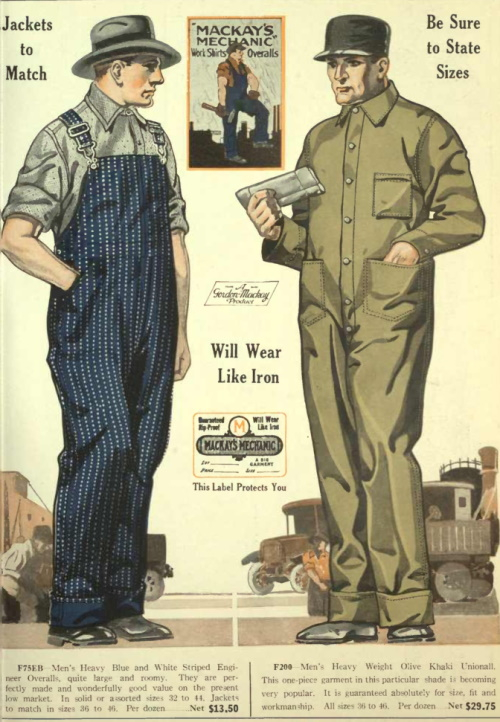
1921 overalls and coveralls
In cooler weather, a rain or oil slicker and fur-lined coat protected men from the elements. Manual labor was very hard. Progress was made for better labor conditions in the 1920s and more time off (yeah weekends!), but the work itself was extremely difficult and not very lucrative. Work clothing took quite a beating and needed to be mended and replaced frequently.
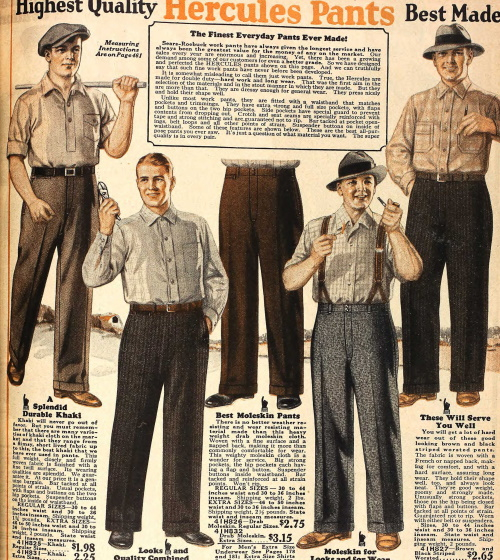
1927 men work shirts, pants, and caps
The hat for most working classes was the 8 panel cap, also called a newsboy cap. It was soft, wide, and puffy, made of wool or tweed. Railroad men sometimes wore striped train conductor style caps. Delivery drivers would wear a fisherman style cap. Other specific jobs require different types of uniform hats.
Learn more about men's vintage workwear clothing.
Men's Formalwear
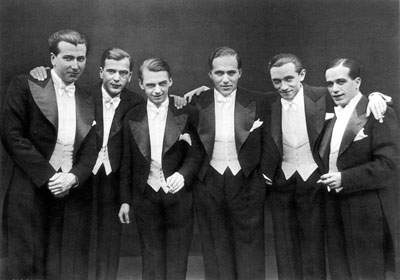
1920's Mens White Tie Formal Wear
Men's 1920s formalwear entailed a black tuxedo with tails or the new style of dinner jacket (now called a tuxedo coat). A white button-down dress shirt with wingtip collar and white or black bow tie was worn under a white or black U-shape vest. Wearing white was the most formal look, while black was for most semi-formal occasions. Black patent leather shoes and a top hat completed the formality.
Young men who did not have the means of purchasing a tuxedo were acceptable in their best suit. The old guard didn't like this much, but establishments like the opera and theater had to lighten the rules, otherwise the young men could not afford it and the art form would die. The white dinner jacket over black pants wasn't worn until the 1930s.
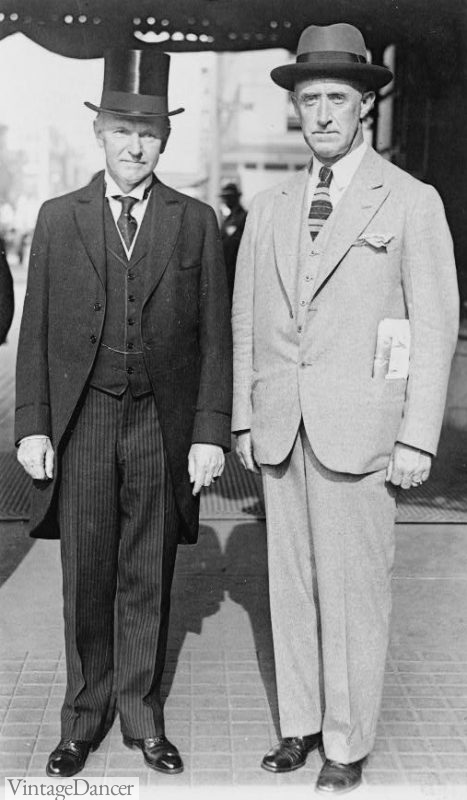
1929 Calvin Coolidge wearing a morning suit.
Certain occupations required men to wear formal clothing. Waiters, bartenders, butlers, hotel managers, and other service-oriented careers required men to dress in their finest formal attire. A lower class establishment, such as a neighborhood bar, would see staff dressed in a button-down shirt with sleeves rolled up to the elbow or help down with sleeve garters. Bankers often wore sleeve garters, too.
Another formal suit worn by business executives, politicians, and grooms was the morning suit. It consisted of grey and black striped pants, grey vest, black morning coat, wingtip shirt, tie, and top hat. It was a style that was fading quickly, except on special occasions and with the upper classes. It has come back around again today in wedding attire for grooms.
Men's Casual Clothes
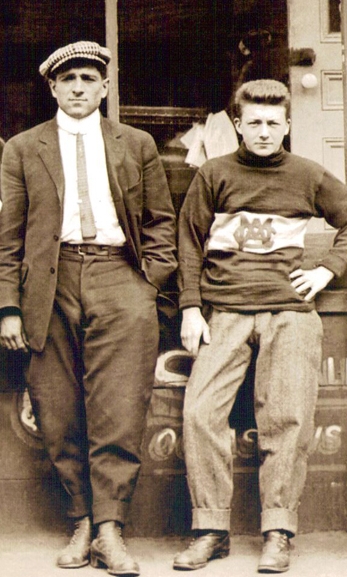
Casual men's clothing (college age)
Sports clothes for men included a pair of pants or knickers called plus fours. These knee-length pants were paired with a patterned sweater or pullover vest and a long sleeve button down shirt with the sleeves rolled up. Argyle was a common sweater or vest print as well as a print for tall socks. Clashing colors were in style! An 8 panel cap (newsboy cap) was also worn, and a pair of two-tone Oxfords or saddle shoes were snazzy.
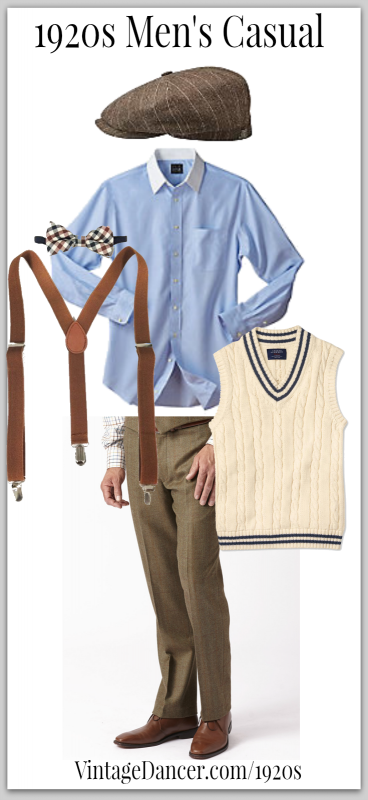
Casual 1920s look can be worn with or without a pullover vest.
Any time a jacket was not worn, a vest was exposed. The current trend for dapper men wearing pants, a vest, shirt, and bow tie (no jacket) reflects this twenties fashion.
For a casual summer outfit, white pants were worn with a casual button-down shirt and white pullover vest or sweater for a look inspired by tennis players.
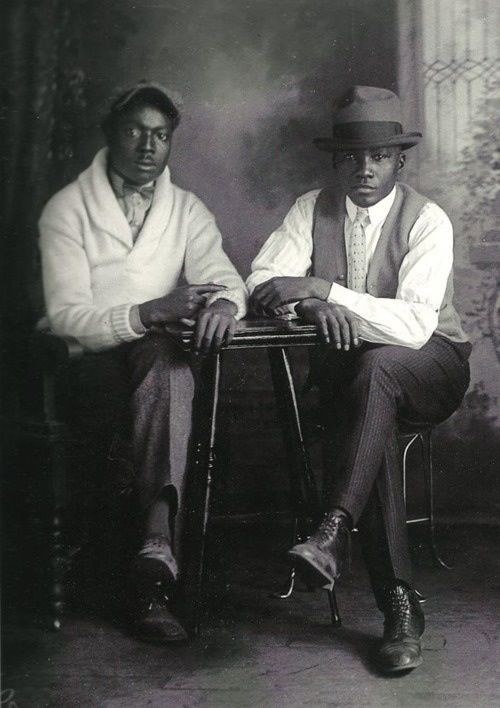
Semi-casual – Sweaters, vests, trousers and hats
College men wore looser suits, often without jackets – just a pair of pants, shirt, tie, belt and maybe a vest. Hats were optional as well. Raccoon coats were not. Whatever the trendy fashion of the year was, college kids had to wear it. They also had to wear college colors in a scarf, a pocket square, bag, hat band, pin, or ring. School spirit was vital to the dress code.
More Men's Outfit Ideas
Easy 1920s men's costume ideas – See how I created 10 men's looks, from casual to formal.
1920s Men's Outfit Inspiration & 20s Costume Ideas
Accurate 1920s Classic Car Show Costumes
1920s Men's Vintage Casual Outfit Ideas
Mens Vintage Boating Outfits, Sailing Clothes
Summer Clothing and Gatsby's white suits recreated.
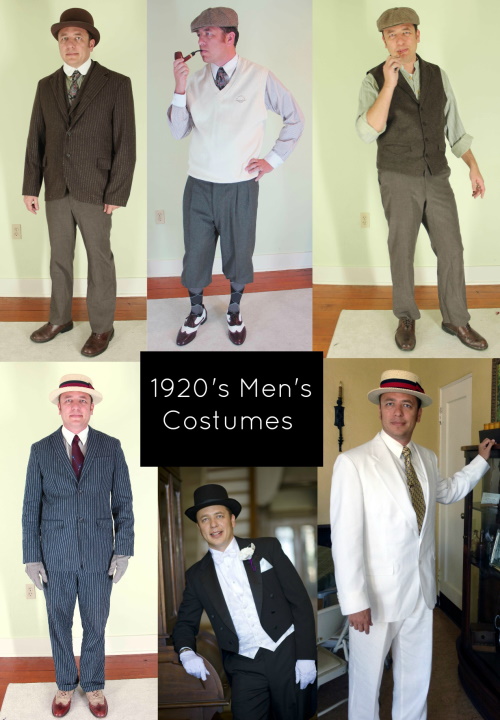
More 1920s men's costume ideas…
What are you going to wear?
So there you have it. Any other type of activity you might encounter was usually determined by the time of day and the indication of formality. So, next time you head to a daytime tea party you will know to wear an afternoon dress or, for men, a summer white suit. For Gatsby's lavish affair, bare your arms and party like it is the day before prohibition starts!
Need help? Contact us anytime.
Source: https://vintagedancer.com/1920s/when-to-wear-what-in-the-1920s/